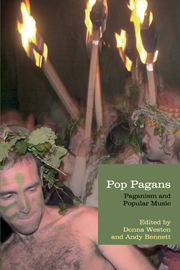Book contents
- Frontmatter
- Contents
- Contributors
- Foreword
- 1 Towards a definition of Pagan music
- Part I Histories
- Part II Genres
- Part III Performance
- 8 Dancing Paganism: music, dance and Pagan identity
- 9 Total solar eclipse festivals, cosmic pilgrims and planetary culture
- 10 Techno-shamanism and the economy of ecstasy as a religious experience
- Part IV Communities
- Bibliography
- Discography and filmography
- Index
10 - Techno-shamanism and the economy of ecstasy as a religious experience
from Part III - Performance
- Frontmatter
- Contents
- Contributors
- Foreword
- 1 Towards a definition of Pagan music
- Part I Histories
- Part II Genres
- Part III Performance
- 8 Dancing Paganism: music, dance and Pagan identity
- 9 Total solar eclipse festivals, cosmic pilgrims and planetary culture
- 10 Techno-shamanism and the economy of ecstasy as a religious experience
- Part IV Communities
- Bibliography
- Discography and filmography
- Index
Summary
Raves, or events revolving around electronic dance music (EDM), consist of people dancing and socializing to an electronic form of music with an accompanying light show and visual effects (Jordan 1995; Martin 1999). Raves range in size from small house parties with thirty or so people in attendance up to massive music festivals attracting crowds of more than thirty thousand (Martin 1999; St John 2009a; Sylvan 2005). These events may occur in urban or rural locations, in clubs or abandoned warehouses, or in outdoor settings on public and private land (Sylvan 2005: 33). Events revolving around EDM became one of the most extensive popular youth movements at the end of the twentieth century, and continue to be popular today on a global scale (Fritz, cited in St John 2009a).
EDM is a genre loosely defined by the use of synthetic electronic instruments in its creation, often in ways that do not sound like traditional musical instruments at all (Gibson & Pagan 2006; Rietveld 2004; St John 2004a). In traditional hardware form, these instruments may include sequencers, synthesizers, drum machines and samplers, all of which are used to make the artificial sounds that comprise most EDM. However, the array of music-making technologies has increased significantly over the last twenty years due to the advent of the personal computer (Rietveld 2004). Many of these innovations consist of cheaper software versions of the previously mentioned hardware music-making tools.
- Type
- Chapter
- Information
- Pop PagansPaganism and Popular Music, pp. 145 - 161Publisher: Acumen PublishingPrint publication year: 2013



